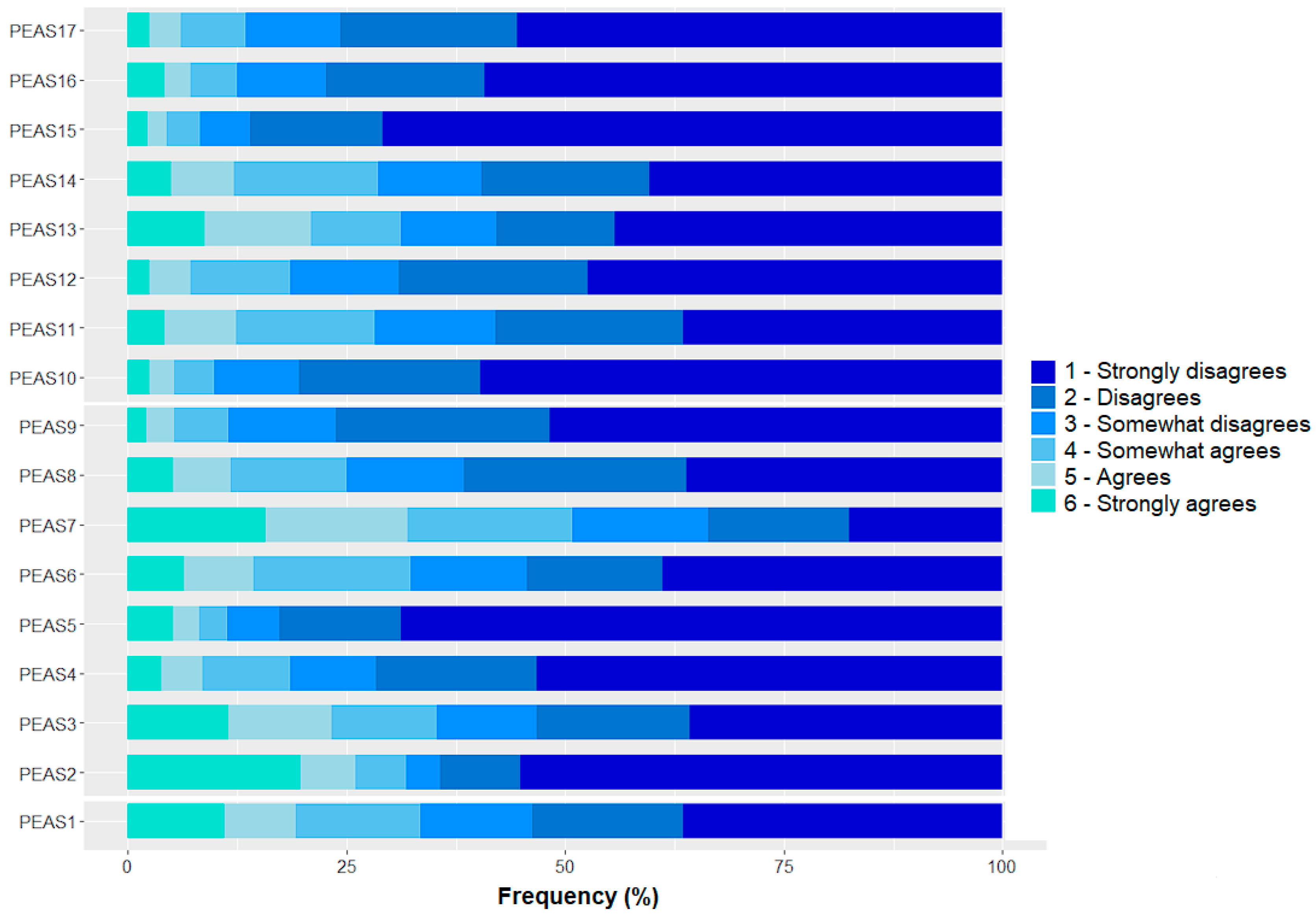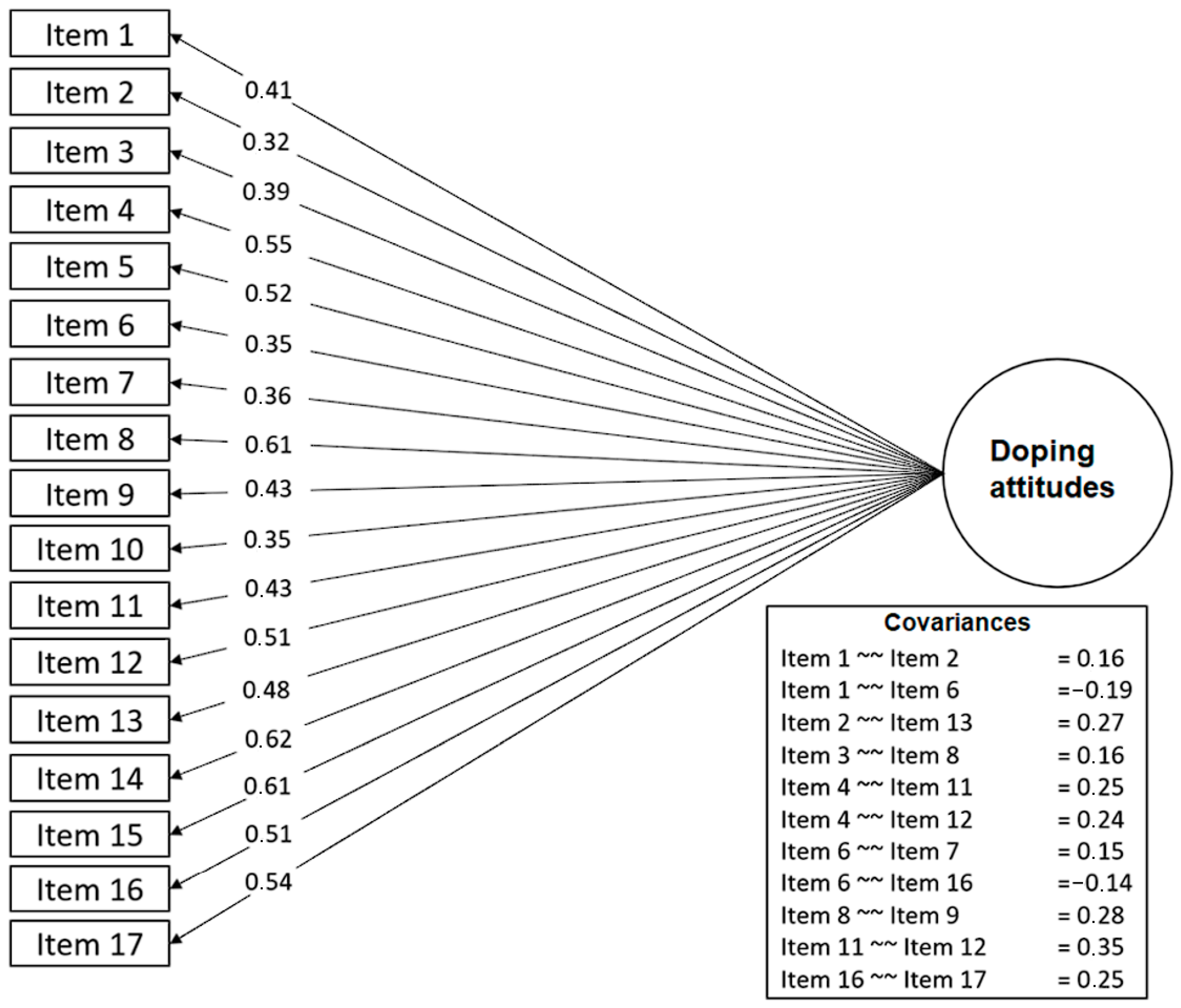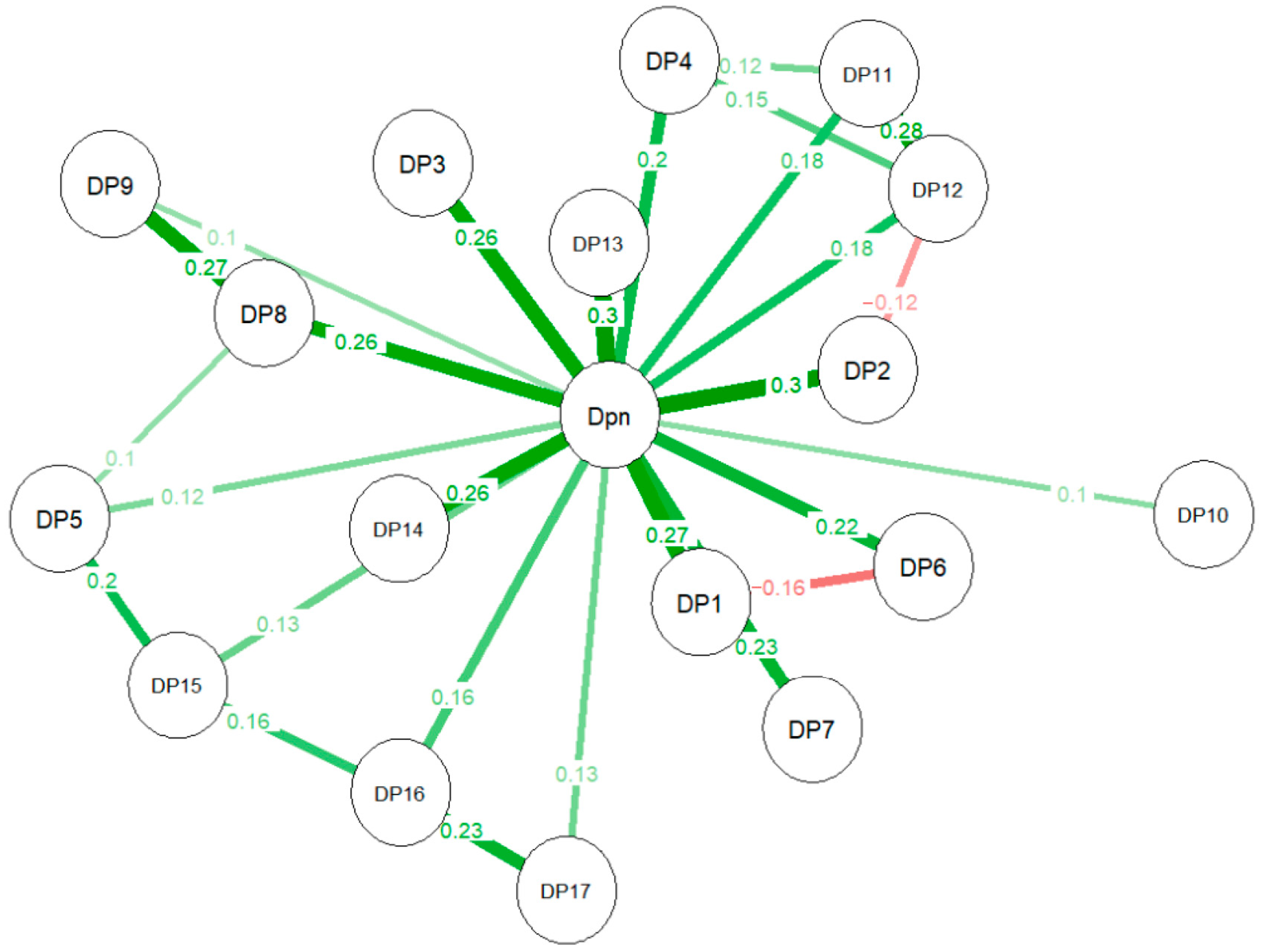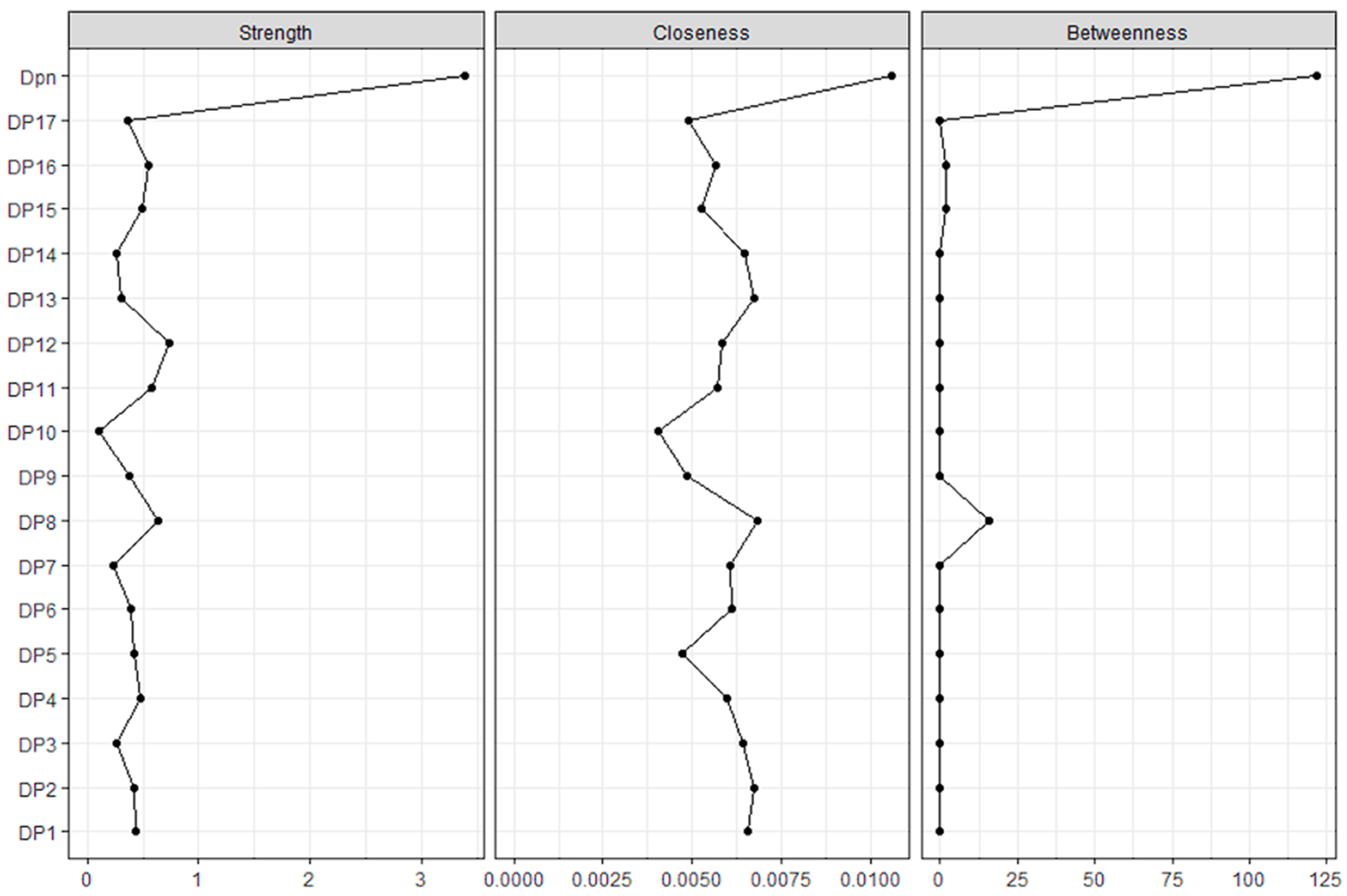Psychometric Properties of the Performance Enhancement Attitude Scale (PEAS) for Brazilian Sports
Abstract
1. Introduction
2. Materials and Methods
2.1. The Performance Enhancement Attitude Scale (PEAS)
2.2. Evidence Based on the Content of the Scale
2.3. Evidence Based on the Response Process, Internal Structure and Reliability of the Scale
Sample Characteristics
2.4. Procedures
2.5. Data Analysis
3. Results
3.1. Evidence Based on the Content of the Scale
3.2. Evidence Based on the Response Process
3.3. Evidence Based on the Internal Structure and Reliability of the Scale
3.4. Measurement Invariance
4. Discussion
5. Conclusions
Author Contributions
Funding
Institutional Review Board Statement
Informed Consent Statement
Data Availability Statement
Conflicts of Interest
References
- World Anti-Doping Association. World Anti-Doping Code 2015. 2015. Available online: https://www.wada-ama.org/sites/default/files/resources/files/wada-2015-world-anti-doping-code.pdf (accessed on 20 March 2024).
- Aguilar-Navarro, M.; Salinero, J.J.; Munoz-Guerra, J.; Plata, M.D.M.; Del Coso, J. Sport-specific use of doping substances: Analysis of World Anti-Doping Agency doping control tests between 2014 and 2017. Subst. Use Misuse 2020, 55, 1361–1369. [Google Scholar] [CrossRef] [PubMed]
- Elbe, A.; Barkoukis, V. The psychology of doping. Curr. Opin. Psychol. 2017, 16, 67–71. [Google Scholar] [CrossRef] [PubMed]
- Nicholls, A.R.; Madigan, D.J.; Backhouse, S.H.; Levy, A.R. Personality traits and performance enhancing drugs: The Dark Triad and doping attitudes among competitive athletes. Personal. Individ. Differ. 2017, 112, 113–116. [Google Scholar] [CrossRef]
- Barkoukis, V.; Lazuras, L.; Tsorbatzoudis, H.; Rodafinos, A. Motivational and social cognitive predictors of doping intentions in elite sports: An integrated approach. Scand. J. Med. Sci. Sports 2013, 23, 330–340. [Google Scholar] [CrossRef]
- Folkerts, D.; Loh, R.; Petróczi, A.; Brueckner, S. The Performance Enhancement Attitude Scale (PEAS) reached ‘adulthood’: Lessons and recommendations from a systematic review and meta-analysis. Psychol. Sport Exerc. 2021, 56, 101999. [Google Scholar] [CrossRef]
- Lazuras, L.; Barkoukis, V.; Tsorbatzoudis, H. Toward an integrative model of doping use: An empirical study with adolescent athletes. J. Sport Exerc. Psychol. 2015, 37, 37–50. [Google Scholar] [CrossRef] [PubMed]
- Hauw, D.; Bilard, J. Understanding appearance-enhancing drug use in sport using an enactive approach to body image. Front. Psychol. 2017, 8, 2088. [Google Scholar] [CrossRef] [PubMed]
- Petróczi, A.; Norman, P.; Brueckner, S. Can we better integrate the role of anti-doping in sports and society? A psychological approach to contemporary value-based prevention. In Acute Topics in Anti-Doping; Karger Publishers: Berlin, Germany, 2017; Volume 62, pp. 160–176. [Google Scholar]
- Ntoumanis, N.; Ng, J.Y.; Barkoukis, V.; Backhouse, S. Personal and psychosocial predictors of doping use in physical activity settings: A meta-analysis. Sports Med. 2014, 44, 1603–1624. [Google Scholar] [CrossRef] [PubMed]
- Blank, C.; Kopp, M.; Niedermeier, M.; Schnitzer, M.; Schobersberger, W. Predictors of doping intentions, susceptibility, and behaviour of elite athletes: A meta-analytic review. SpringerPlus 2016, 5, 1333. [Google Scholar] [CrossRef]
- Petróczi, A. Exploring the Doping Dilemma in Elite Sport: Can Athletes’ Attitudes Be Responsible for Doping? Ph.D. Thesis, University of Northern Colorado, Greeley, CO, USA, 2002. [Google Scholar]
- Petróczi, A.; Aidman, E. Measuring explicit attitude toward doping: Review of the psychometric properties of the Performance Enhancement Attitude Scale. Psychol. Sport Exerc. 2009, 10, 390–396. [Google Scholar] [CrossRef]
- Elbe, A.-M.; Brand, R.; Schlegel, M.; Melzer, M. Being a Fair Sportsman. Ethical Decision-Making as a Chance for Doping Prevention? (WADA Social Science Research Report). World Anti-Doping Agency (WADA) 2012. Available online: https://www.wada-ama.org/sites/default/files/resources/files/elbe_-_2008_final_report.pdf (accessed on 20 March 2024).
- Moran, A.; Guerin, S.; Kirby, K.; MacIntyre, T. The Development and Validation of a Doping Attitudes and Behaviour Scale; WADA Social Science Research Report; World Anti-Doping Agency (WADA). 2008. Available online: https://www.wada-ama.org/sites/default/files/resources/files/moran_final_report.pdf (accessed on 20 March 2024).
- Bondarev, D.; Galchinskiy, V.; Ajitskiy, K.; Labskir, V. A Study of Surroundings’ Influence on Attitude towards and Behavior Regarding Doping; WADA Social Science Research Report; World Anti-Doping Agency (WADA). 2009. Available online: https://www.wada-ama.org/sites/default/files/resources/files/bondarev_eng_-_final_report_2009_funded_-_attitude_and_behaviour.pdf (accessed on 20 March 2024).
- Dimeo, P.; Allen, J.; Taylor, J.; Dixon, S.; Robinson, L. Team Dynamics and Doping in Sport: A Risk or a Protective Factor; WADA Social Science Research Report; World Anti-Doping Agency (WADA). 2011. Available online: https://www.wada-ama.org/sites/default/files/resources/files/dimeo_team_dynamics_2011_report_en.pdf (accessed on 20 March 2024).
- Skinner, J.; Moston, S.; Engelberg, T. The Relationship between Moral Code, Participation in Sport, and Attitudes, towards Performance Enhancing Drugs in Young People; WADA Social Science Research Report; World Anti-Doping Agency (WADA): 2012. Available online: https://www.wada-ama.org/sites/default/files/resources/files/skinner_moston_engelberg_2012_final_report_to_wada_30-03-12.pdf (accessed on 20 March 2024).
- Kamenju, J.; Mwisukha, A.; Rintaugu, E. Awareness, Perception and Attitude to Performance-Enhancing Drugs and Substance Use among Athletes in Teacher Training Colleges in Kenya; WADA Social Science Research Report; World Anti-Doping Agency (WADA). 2016. Available online: https://www.wada-ama.org/sites/default/files/resources/files/awareness_perception_and_attitude_to_peds_in_kenya_-_kamenju.pdf (accessed on 20 March 2024).
- Morente-Sánchez, J.; Zabala, M. Doping in sport: A review of elite athletes’ attitudes, beliefs, and knowledge. Sports Med. 2013, 43, 395–411. [Google Scholar] [CrossRef] [PubMed]
- Chan, D.K.C.; Tang, T.C.W.; Gucciardi, D.F.; Ntoumanis, N.; Dimmock, J.A.; Donovan, R.J.; Hardcastle, S.J.; Hagger, M.S. Psychological and behavioural factors of unintentional doping: A preliminary systematic review. Int. J. Sport Exerc. Psychol. 2018, 18, 273–295. [Google Scholar] [CrossRef]
- Madigan, D.J.; Mallinson-Howard, S.H.; Grugan, M.C.; Hill, A.P. Perfectionism and attitudes towards doping in athletes: A continuously cumulating meta-analysis and test of the 2 × 2 model. Eur. J. Sport Sci. 2019, 20, 1245–1254. [Google Scholar] [CrossRef] [PubMed]
- Pasquali, L. Validade dos Testes Psicológicos: Será Possível Reencontrar o Caminho? Psicol. Teor. E Pesqui. 2007, 23, 99–107. [Google Scholar] [CrossRef]
- Kline, R.B. Principles and Practice of Structural Equation Modeling; The Guilford Press: New York, NY, USA, 2015. [Google Scholar]
- Hu, L.-T.; Bentler, P.M. Cutoff criteria for fit indexes in covariance structure analysis: Conventional criteria versus new alternatives. Struct. Equ. Model. 1999, 6, 1–55. [Google Scholar] [CrossRef]
- Hair, J.; Black, W.; Balbin, B.; Anderson, R.; Tathan, R. Análise Multivariada De Dados; Bookman: São Paulo, SP, Brazil, 2009. [Google Scholar]
- DeVellis, R.F. Scale Development: Theory and Applications; SAGE Publications: Los Angeles, CA, USA, 2012. [Google Scholar]
- Wang, S.; Jones, P.; Dreier, M.; Elliott, H.; Grilo, C. Core psychopathology of treatment-seeking patients with binge-eating disorder: A network analysis investigation. Psychol. Med. 2018, 49, 1923–1928. [Google Scholar] [CrossRef]
- Silva, A.B.O.; Matheus, R.F.; Parreiras, F.S.; Parreiras, T.A.S. Estudo da rede de coautoria e da interdisciplinaridade na produção científica com base nos métodos de análise de redes sociais: Avaliação do caso do programa de pós-graduação em ciência da informação—Ppgci/Ufmg. Encontros Bibli Rev. Elet. De Bibliotec. E Cienc. Da Inf. 2006, 11, 179–194. [Google Scholar] [CrossRef]
- Mullan, E.; Markland, D.; Ingledew, D. A graded conceptualisation of self-determination in the regulation of exercise behaviour: Development of a measure using confirmatory factor analytic procedures. Personal. Individ. Differ. 1997, 23, 745–752. [Google Scholar] [CrossRef]
- Brown, T.A. Confirmatory Factor Analysis for Applied Research; The Guilford Press: New York, NY, USA, 2015. [Google Scholar]
- Hevey, D. Network analysis: A brief overview and tutorial. Health Psychol. Behav. Med. 2018, 6, 301–328. [Google Scholar] [CrossRef]
- Hauw, D.; Crettaz von Roten, F.; Mohamed, S.; Antonini Philippe, R. Psychometric properties of the French-language version of the Performance Enhancement Attitude Scale (PEAS). Eur. Rev. Appl. Psychol. 2016, 66, 15–21. [Google Scholar] [CrossRef]
- Morente-Sánchez, J.; Femia-Marzo, P.; Zabala, M. Cross-cultural adaptation and validation of the Spanish version of the Performance Enhancement Attitude Scale (Petróczi, 2002). J. Sports Sci. Med. 2014, 13, 430–438. [Google Scholar] [PubMed]
- Divkan, B.; Tojari, F.; Mosavi, S.M.; Ganjouei, F. Development and validation of Performance Enhancement Attitude toward Doping scale in elite athletes of Iran. Adv. Environ. Biol. 2013, 7, 3345–3349. [Google Scholar]
- Soltanabadi, S.; Tojari, F.; Manouchechri, J. Validity and reliability of measurement instruments of doping attitudes and doping behavior in iranian professional athletes of team sports. Indian J. Fundam. Appl. Life Sci. 2014, 4, 280–286. [Google Scholar]
- Elbe, A.-M.; Brand, R. The effect of an ethical decision-making training on young athletes’ attitudes toward doping. Ethics Behav. 2016, 26, 32–44. [Google Scholar] [CrossRef]
- Sas-Nowosielski, K.; Budzisz, A. Attitudes toward doping among Polish athletes measured with the Polish version of Petroczi’s Performance Enhancement Attitude Scale. Pol. J. Sport Tour. 2018, 25, 10–13. [Google Scholar] [CrossRef]




| Item | CVCi | |
|---|---|---|
| 1 | Legalizar produtos para melhoria de rendimento seria benéfico para o esporte. | 0.93 |
| 2 | Doping é necessário para ser competitivo. | 0.93 |
| 3 | Os riscos relacionados ao doping são exagerados. | 0.99 |
| 4 | Drogas recreativas motivam para treinar e competir em alto nível. | 0.96 |
| 5 | Atletas não deveriam se sentir culpados por quebrar as regras e usar drogas para melhorar o rendimento. | 0.96 |
| 6 | Atletas são pressionados a usar drogas para melhorar o rendimento. | 0.96 |
| 7 | Problemas de saúde relacionados ao treinamento rigoroso e às lesões são tão ruins quanto o doping. | 0.93 |
| 8 | A mídia trata a questão do doping de forma desproporcional. | 0.83 |
| 9 | A mídia deveria falar menos sobre o doping. | 0.99 |
| 10 | Atletas não têm nenhuma opção de escolha de carreira, a não ser o esporte. | 0.56 |
| 11 | Atletas que usam drogas recreativas, as usam porque ajudam em situações esportivas. | 0.93 |
| 12 | Drogas recreativas ajudam a superar o tédio durante os treinamentos. | 0.93 |
| 13 | Doping é uma parte inevitável do esporte competitivo. | 0.96 |
| 14 | Atletas muitas vezes perdem tempo devido a lesões, e as drogas podem ajudar a compensar esse tempo perdido. | 0.99 |
| 15 | Doping não é trapaça, já que todo mundo faz uso. | 0.93 |
| 16 | Somente a qualidade do rendimento deveria importar, não a forma como os atletas o alcançam. | 0.93 |
| 17 | Não há diferença entre drogas e o equipamento técnico que pode ser usado para melhorar o rendimento (ex.: câmara hipobárica para simular altitude, maiôs velozes, varas de fibras de vidro). | 0.86 |
| CVC total | 0.90 |
| 1 | 2 | 3 | 4 | 5 | 6 | 7 | 8 | 9 | 10 | 11 | 12 | 13 | 14 | 15 | 16 | 17 | |
|---|---|---|---|---|---|---|---|---|---|---|---|---|---|---|---|---|---|
| Item 1 | - | ||||||||||||||||
| Item 2 | 0.34 | - | |||||||||||||||
| Item 3 | 0.30 | 0.20 | - | ||||||||||||||
| Item 4 | 0.36 | 0.36 | 0.34 | - | |||||||||||||
| Item 5 | 0.33 | 0.25 | 0.31 | 0.47 | - | ||||||||||||
| Item 6 | −0.01 | 0.10 | 0.11 | 0.23 | 0.21 | - | |||||||||||
| Item 7 | 0.14 | 0.18 | 0.19 | 0.23 | 0.25 | 0.29 | - | ||||||||||
| Item 8 | 0.33 | 0.24 | 0.43 | 0.43 | 0.54 | 0.29 | 0.30 | - | |||||||||
| Item 9 | 0.26 | 0.24 | 0.27 | 0.30 | 0.40 | 0.16 | 0.22 | 0.58 | - | ||||||||
| Item 10 | 0.16 | 0.10 | 0.19 | 0.26 | 0.29 | 0.17 | 0.19 | 0.23 | 0.35 | - | |||||||
| Item 11 | 0.19 | 0.20 | 0.21 | 0.52 | 0.30 | 0.26 | 0.20 | 0.35 | 0.26 | 0.26 | - | ||||||
| Item 12 | 0.22 | 0.15 | 0.20 | 0.56 | 0.37 | 0.29 | 0.25 | 0.42 | 0.32 | 0.28 | 0.59 | - | |||||
| Item 13 | 0.22 | 0.47 | 0.23 | 0.34 | 0.30 | 0.27 | 0.24 | 0.33 | 0.28 | 0.23 | 0.27 | 0.37 | - | ||||
| Item 14 | 0.25 | 0.26 | 0.33 | 0.39 | 0.40 | 0.35 | 0.30 | 0.45 | 0.31 | 0.25 | 0.39 | 0.46 | 0.46 | - | |||
| Item 15 | 0.34 | 0.31 | 0.31 | 0.43 | 0.60 | 0.25 | 0.22 | 0.53 | 0.47 | 0.38 | 0.34 | 0.43 | 0.46 | 0.49 | - | ||
| Item 16 | 0.35 | 0.23 | 0.29 | 0.35 | 0.47 | 0.11 | 0.20 | 0.41 | 0.41 | 0.33 | 0.26 | 0.33 | 0.34 | 0.45 | 0.59 | - | |
| Item 17 | 0.22 | 0.16 | 0.25 | 0.35 | 0.43 | 0.25 | 0.25 | 0.40 | 0.35 | 0.33 | 0.32 | 0.42 | 0.35 | 0.49 | 0.54 | 0.59 | - |
| Total Score | 0.51 | 0.54 | 0.52 | 0.71 | 0.70 | 0.43 | 0.47 | 0.71 | 0.56 | 0.48 | 0.57 | 0.64 | 0.62 | 0.68 | 0.79 | 0.64 | 0.65 |
| Model | X2/df | P | RMSEA | p-RMSEA | CFI | TLI | SRMR |
|---|---|---|---|---|---|---|---|
| Sex | |||||||
| 1: Configural | 1.42 | 0.00 | 0.026 | 1.00 | 0.988 | 0.984 | 0.039 |
| 2: Metric | 1.31 | 0.00 | 0.027 | 1.00 | 0.985 | 0.983 | 0.044 |
| 3: Scalar | 1.29 | 0.00 | 0.026 | 1.00 | 0.985 | 0.984 | 0.045 |
| 4: Full uniqueness | 1.31 | 0.00 | 0.028 | 1.00 | 0.983 | 0.982 | 0.051 |
| Type of sport | |||||||
| 1: Configural | 1.46 | 0.00 | 0.027 | 1.00 | 0.987 | 0.984 | 0.039 |
| 2: Metric | 1.24 | 0.00 | 0.024 | 1.00 | 0.989 | 0.987 | 0.042 |
| 3: Scalar | 1.51 | 0.00 | 0.034 | 1.00 | 0.976 | 0.973 | 0.048 |
| 4: Full uniqueness | 1.58 | 0.00 | 0.037 | 1.00 | 0.969 | 0.968 | 0.055 |
Disclaimer/Publisher’s Note: The statements, opinions and data contained in all publications are solely those of the individual author(s) and contributor(s) and not of MDPI and/or the editor(s). MDPI and/or the editor(s) disclaim responsibility for any injury to people or property resulting from any ideas, methods, instructions or products referred to in the content. |
© 2024 by the authors. Licensee MDPI, Basel, Switzerland. This article is an open access article distributed under the terms and conditions of the Creative Commons Attribution (CC BY) license (https://creativecommons.org/licenses/by/4.0/).
Share and Cite
Codonhato, R.; Aizava, P.V.S.; Berbery, E.; Fiorese, L. Psychometric Properties of the Performance Enhancement Attitude Scale (PEAS) for Brazilian Sports. Behav. Sci. 2024, 14, 425. https://doi.org/10.3390/bs14060425
Codonhato R, Aizava PVS, Berbery E, Fiorese L. Psychometric Properties of the Performance Enhancement Attitude Scale (PEAS) for Brazilian Sports. Behavioral Sciences. 2024; 14(6):425. https://doi.org/10.3390/bs14060425
Chicago/Turabian StyleCodonhato, Renan, Paulo Vitor Suto Aizava, Enzo Berbery, and Lenamar Fiorese. 2024. "Psychometric Properties of the Performance Enhancement Attitude Scale (PEAS) for Brazilian Sports" Behavioral Sciences 14, no. 6: 425. https://doi.org/10.3390/bs14060425
APA StyleCodonhato, R., Aizava, P. V. S., Berbery, E., & Fiorese, L. (2024). Psychometric Properties of the Performance Enhancement Attitude Scale (PEAS) for Brazilian Sports. Behavioral Sciences, 14(6), 425. https://doi.org/10.3390/bs14060425







